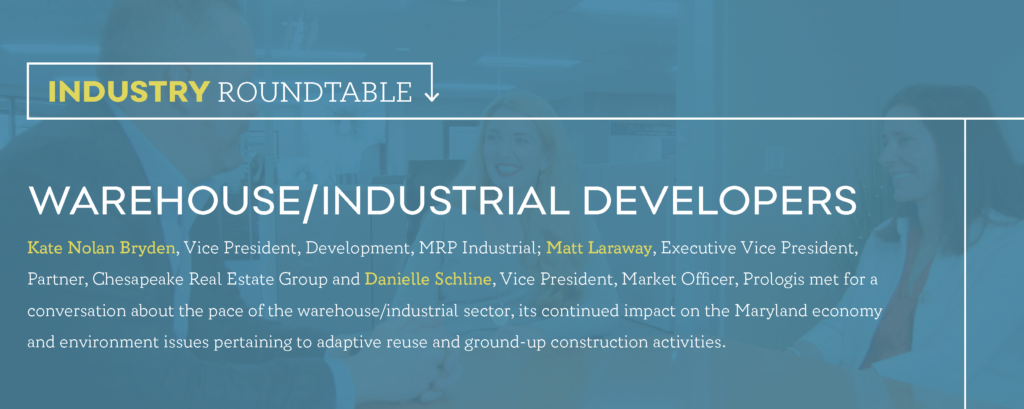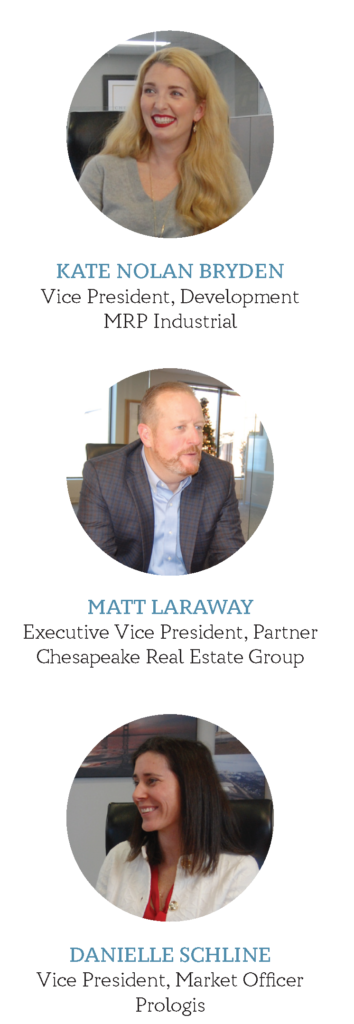
INDUSTRIAL PRODUCT AS A JOB CREATOR

KATE NOLAN BRYDEN (KNB): There exists a false perception that, due to the rise of technologically-savvy warehouse users, these large buildings require less employees to operate the uses. In reality, that is not the case with many of the jobs requiring skilled workers. Then, there are all the ancillary jobs that spin off such
as delivery drivers that provide last-mile distribution. These positions, the volume of which did not exist 10 years ago, have exploded and will continue to do so.
MATT LARAWAY (ML): And then there are all the construction jobs that emerge from a large-scale development site such as our Brandon Woods III project, a 259-acre business community in Anne Arundel County. At times, the activity would resemble an ant farm with an average of more than 70 construction workers on-site on a daily basis. We estimate approximately 400 different construction personnel have invested time on the site thus far.
DANIELLE SCHLINE (DS): Also easily forgotten is the significant investment and jobs created to complete tenant improvement packages, some of which are extremely complicated and expensive. We’ve spent several million dollars this year alone in the local area for various build-outs.
CONSUMER LIFESTYLES DRIVE WAREHOUSE DEVELOPMENT
KNB: The insatiable demand for large warehouse and logistics centers is driven by the reshaping of consumer buying habits. Online purchases for Black Friday rose nearly 15 percent and Cyber Monday shopping rose by nearly 20 percent. This number will continue to rise, of course, as the types of goods bought online continues to expand. This should stimulate the need for additional real estate product, particularly properties near major population centers.
ML: Next-day delivery is no longer good enough for many consumers and, instead, they demand the receipt of goods within several hours of the purchase. This is creating the need for smaller warehouses that serve the larger ones to complete last- mile delivery. We are seeing modifications to corporate supply chains as well, as modeled after national retailers. A major local healthcare organization recently reconfigured its supply chain to create a large warehouse that services its various hospitals and doctor’s offices. So, a hospital gown, for instance, will begin its delivery path from this building as opposed to many smaller supply rooms that required employee oversight and tracking.
DS: Much of the growth is connected to consumer confidence, and the Baltimore- Washington, D.C. market behaves differently — and much better — than other sections of the country. During recessions, we do not dip down as far as other markets. A lot can be contributed to our proximity to the federal government because, during down times, people flock back to the area to achieve security and balance.
WORKING TO MITIGATE HARM TO THE ENVIRONMENT
KNB: As the LEED rating system evolved, the focus of the rating system seemed to shift toward urban and office developments and largely penalized industrial buildings for their location on greenfield sites located in more rural areas without recognizing the benefit that integrating sustainable elements can have at such a large scale. That said, many industrial developers and end users continue to be focused on improving the operational efficiency and reducing the environmental impact of these buildings. It is hard to think of a site where the stormwater system is not managed and infiltrated onsite to avoid negative impact to a downstream condition. Warehouses are tremendous consumers of electricity and so have a greater positive impact on area grid resources when developed with energy- efficient LED lighting and robust envelope insulation. Other common sustainable practices, though, like adaptive reuse have been harder to implement with industrial products because often both the building and the site are functionally obsolete. While building issues can be corrected, site challenges are more difficult to remedy. It is easier to start over. We may start to see more urban infill as opportunities as delivery technologies improve and relieve the need for strict site parking and circulation requirements.
ML: It is not feasible to integrate LEED standard features into a speculative building without knowing the needs of the eventual tenant, which typically makes these decisions. When tackling an adaptive reuse, nine out of 10 times the new owner will execute a volunteer clean-up and remediation which includes the capping of the site with clean fill. The result is the completion of a project with a clean bill of health and delivering a site that is significantly better for the environment than where it started. It is not often that you find a site with no environment issues beforehand and we are removing liabilities.
DS: Prologis built a carbon-neutral facility in Germany for L’Oréal, and I am certain you will see this mirrored in the United States. It is operated by sustainable energy and collected rainwater is used to flush the toilets and irrigate the landscaping. The rooftop features more than 7,000 solar panels that generate 2.0 megawatts of electricity. Certain buildings become absolute needs for a company due to its location, and it becomes the responsibility of the developer to make sure the environmental issues are worked out.
PREDICTING THE LENGTH OF THE RUNWAY
KNB: This is truly impacted by so many factors, specifically the economy and consumer spending, but industrial product types function quite differently than others. Even in an economic downturn, consumers will keep purchasing food, clothing, and other necessities. And, especially when shipping is inexpensive or free, they will still want products delivered to their home.
ML: Developers were responsible in this region and product was not overbuilt, which is extremely encouraging. A healthy pipeline remains, but I am not concerned with all the new product that exists in the current inventory. Some of the buildings in the outlining suburbs might struggle a bit to find suitable tenants but I do not see the end of the runway at this point.
DS: E-commerce gets most of the headlines, but the continuing demand for reverse logistics to handle consumer returns will remain a major growth sector in the coming years. Also in high demand are cold storage facilities and data centers, with the Northern Virginia area remaining as the location of choice for this specialized use.
Originally published in January/February 2020 NAIOP-MD InSites.